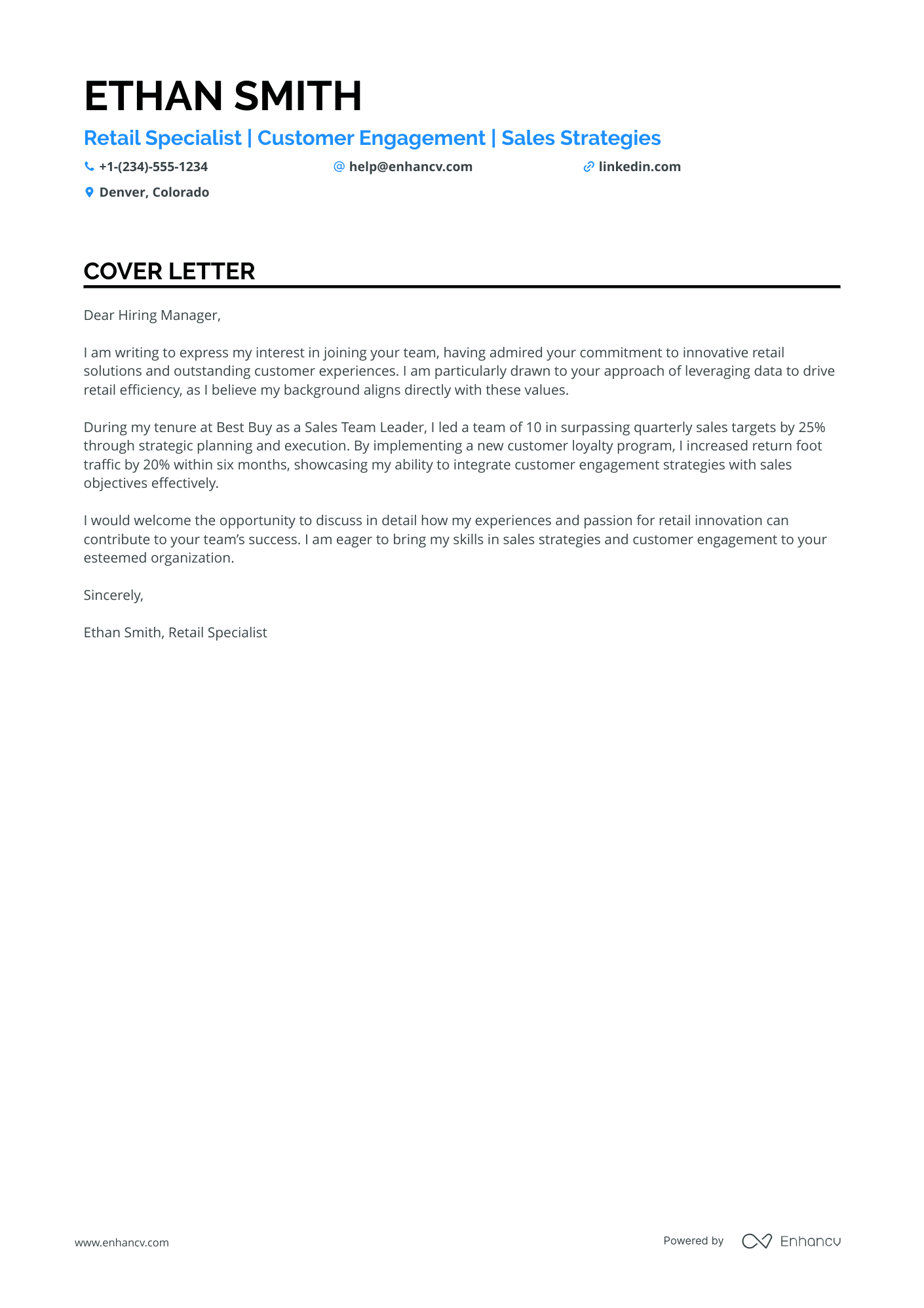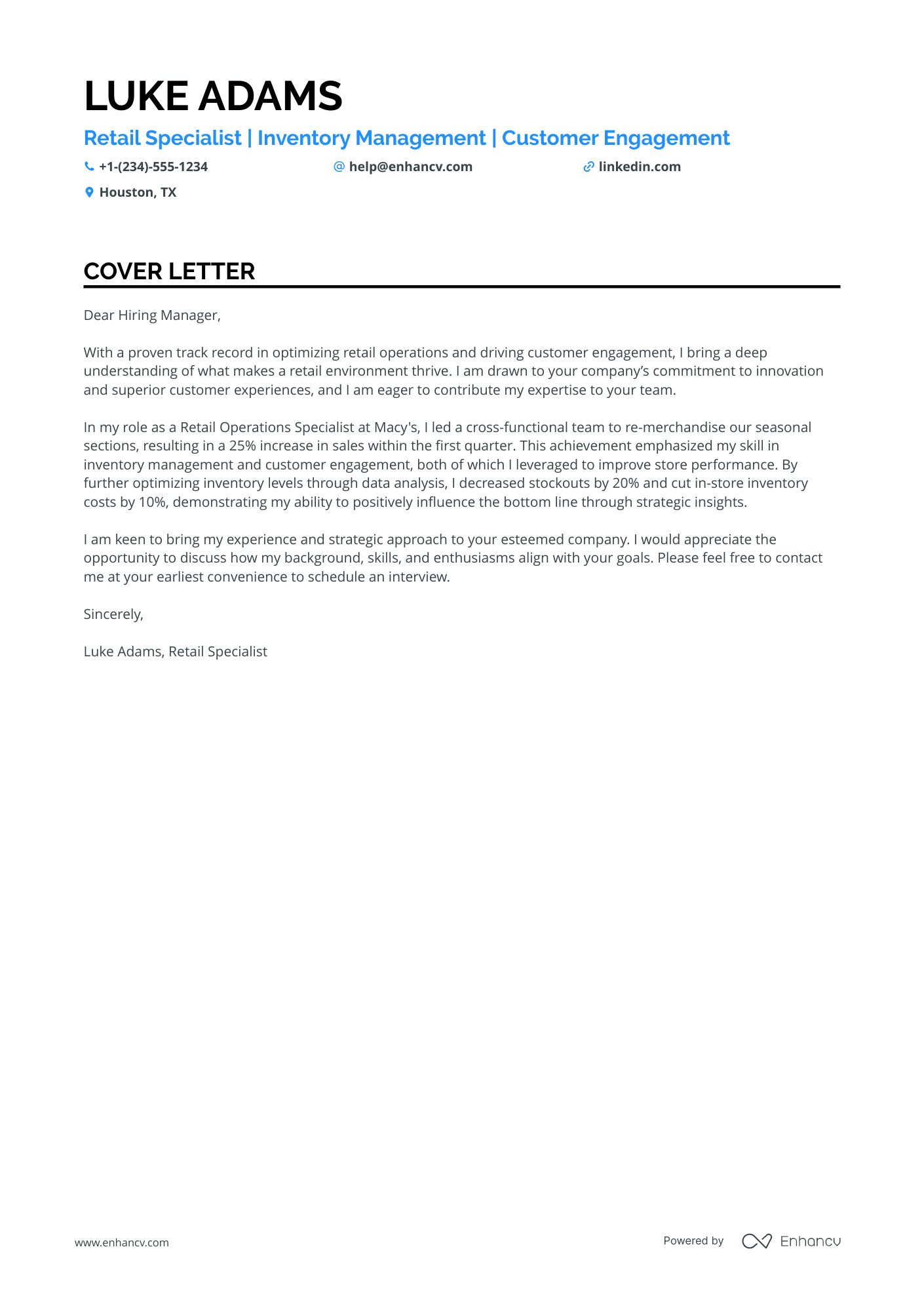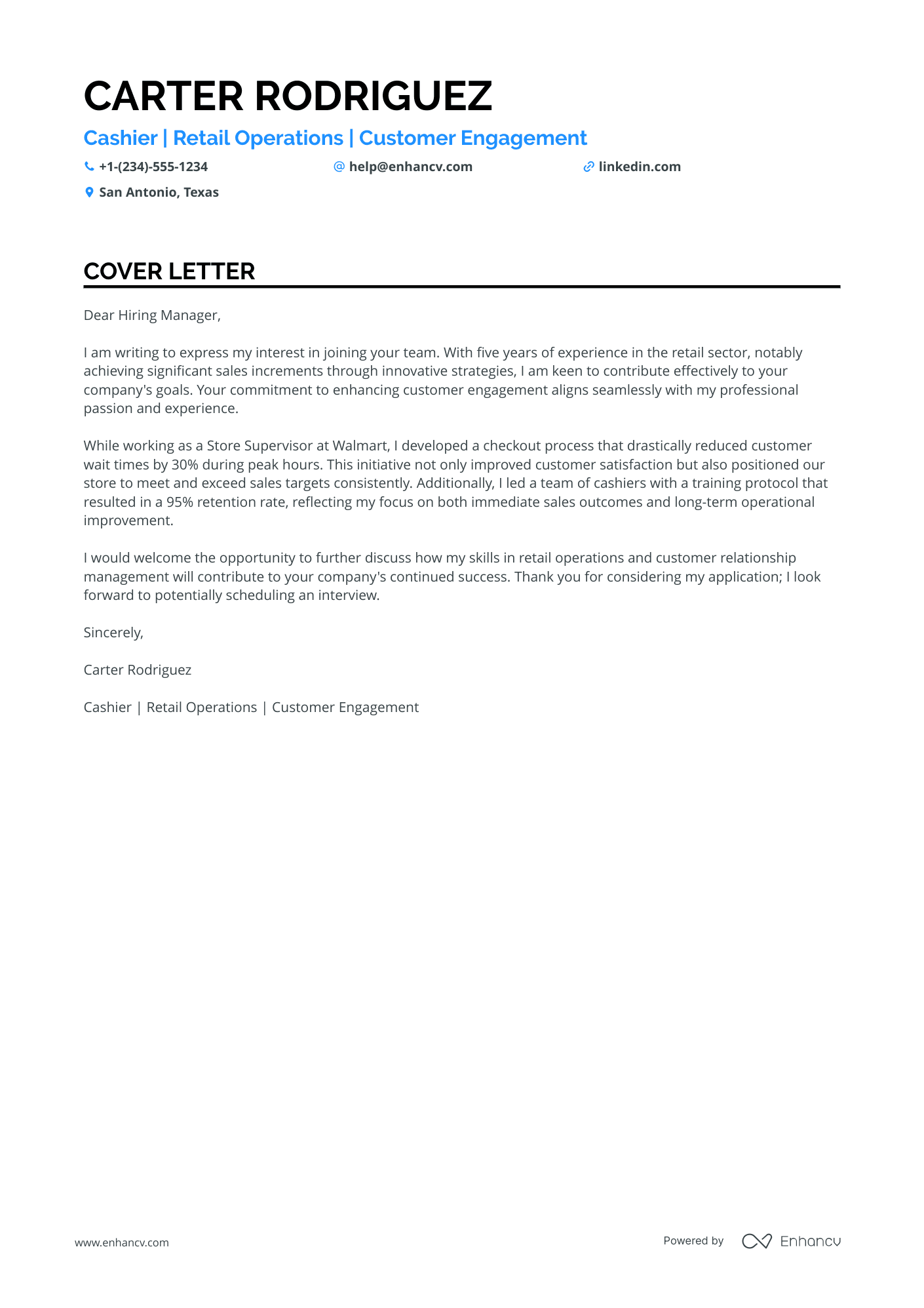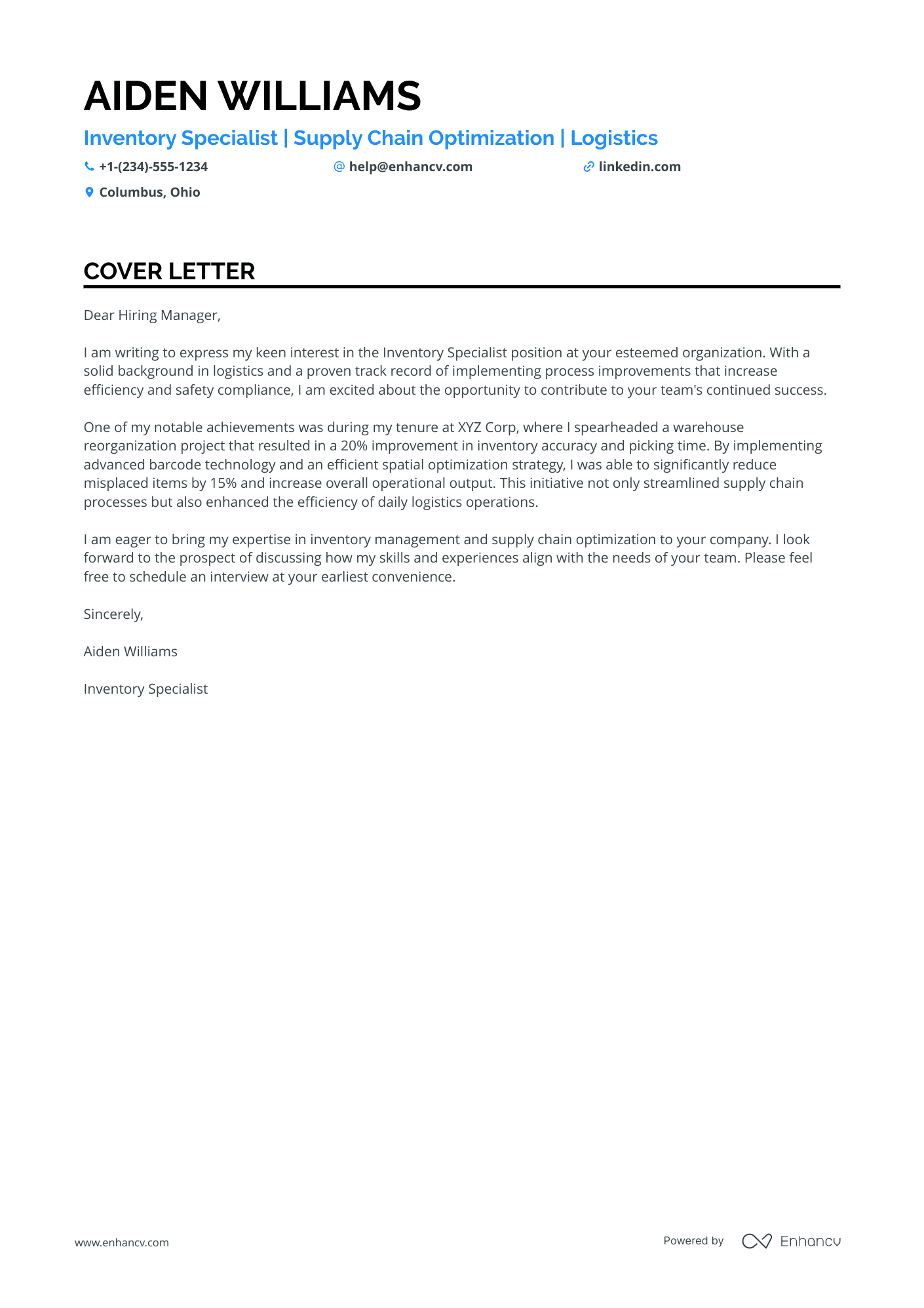As you dive into the job application process, you realize a persuasive target cover letter can be the key to landing your dream role. Struggling to condense your professional life into one page without echoing your resume? Your cover letter is your chance to share a compelling story about your proudest achievement, not a list of clichés. Keep it concise and engaging, and watch employers take notice. Let's unlock the secrets to crafting a cover letter that truly stands out.
- Making excellent use of job-winning real-life professional cover letters;
- Writing the first paragraphs of your target cover letter to get attention and connect with the recruiters - immediately;
- Single out your most noteworthy achievement (even if it's outside your career);
- Get a better understanding of what you must include in your target cover letter to land the job.
Let the power of Enhancv's AI work for you: create your target cover letter by uploading your resume.
If the target isn't exactly the one you're looking for we have a plethora of cover letter examples for jobs like this one:
- Target resume guide and example
- Pharmaceutical Sales Rep cover letter example
- Sales Manager cover letter example
- Sales Consultant cover letter example
- Sales And Marketing Manager cover letter example
- Executive Sales cover letter example
- Overnight Stocker cover letter example
- Sales Administrator cover letter example
- Furniture Sales cover letter example
- Sales Development Representative cover letter example
- Hotel Sales Manager cover letter example
Target cover letter example
Payton Webster
Austin, TX
+1-(234)-555-1234
help@enhancv.com
- Aligning with Company Ethos: The cover letter effectively ties the candidate's professional goals with the company's customer-centric values. This demonstrates the applicant's understanding of Target's brand and a clear desire to contribute positively to it.
- Demonstrating Relevant Experience: Citing a specific achievement where the candidate increased productivity by 30% and exceeded sales targets provides concrete evidence of their capacity to deliver results and manage a team effectively, which directly relates to the role in question.
- Call to Action: The cover letter includes a call to action, inviting the hiring manager to schedule a meeting. This proactiveness shows the candidate's eagerness to engage further and discuss how their skills can benefit Target specifically.
What are the basics of the design or format of your target cover letter?
To start, here's a reminder for you: the Applicant Tracker System (or software that is used to assess candidate profiles), won't be reading your target cover letter.
Recruiters enjoy reading target cover letters with a standardized format that uses:
- the same font as the resume (e.g. modern ones like Raleway or Volkhov are prefered over the clichéd Times New Roman or Arial);
- single spacing to keep the content concise and organized (this is all ready for you in our cover letter templates);
- a one-inch margin to wrap around the text, like in our cover letter builder;
- PDF as a file format, as it allows your design (and visual element) to stay the same.
Finally, we can't go on without mentioning the key sections of your target cover letter.
In the top one-third, make sure to include a header (with your contact information, name, role, and date), a salutation, and an introduction.
Next, follows the heart and soul of your target cover letter or its body.
End your target cover letter with a closing paragraph and, if you wish, a signature.
Pressed for time? Use our free cover letter generator to turn your resume into a cover letter effortlessly.
The top sections on a target cover letter
- Header: Includes your contact information, the date, and the employer's contact information, which is important for setting a professional tone and ensuring the recruiter knows who you are and how to get back to you.
- Opening Greeting: Addresses the hiring manager by name whenever possible, showing that you've done your research and are personally engaged in the application process.
- Introduction: Clearly states the position you are applying for and gives a brief overview of your relevant experience and skills, grabbing the recruiter's attention and showing immediate relevancy.
- Body Paragraph(s): Showcases your specific experiences, accomplishments, and skills that align with the key responsibilities of the role, making it clear why you're a good match for this specific job.
- Closing Section: Includes a call to action, such as requesting an interview, and reiterates your enthusiasm for the role, leaving the recruiter with a strong, memorable conclusion to your cover letter.
Key qualities recruiters search for in a candidate’s cover letter
Since you haven't specified a job title, I'll choose a common position for the example: Software Engineer. Here are six key qualities, experiences, and traits specific to that role:
- Proficiency in relevant programming languages (e.g., Java, Python, C#) - Essential for writing, testing, and maintaining code.
- Experience with software development methodologies (e.g., Agile, Scrum) - Allows effective collaboration in team settings and agile response to project changes.
- Strong problem-solving skills - Critical for debugging and implementing efficient solutions.
- Knowledge of database management and SQL - Necessary for managing and manipulating data within software applications.
- Experience with version control systems (e.g., Git) - Important for tracking changes, collaborating with others, and deploying code.
- Understanding of software security practices - Ensures the development of secure applications and protection of sensitive data.
Personalizing your target cover letter salutation
Always aim to address the recruiter from the get-go of your target cover letter.
Use:
- the friendly tone (e.g. "Dear Paul" or "Dear Caroline") - if you've previously chatted up with them on social media and are on a first-name basis;
- the formal tone (e.g. "Dear Ms. Gibbs" or "Dear Ms. Swift") - if you haven't had any previous conversation with them and have discovered the name of the recruiter on LinkedIn or the company website;
- the polite tone (e.g. "Dear Hiring Manager" or "Dear HR Team") - at all costs aim to avoid the "To whom it may concern" or "Dear Sir/Madam", as both greetings are very old-school and vague.
List of salutations you can use
- Dear Hiring Manager,
- Dear [Specific Role Title] Hiring Team,
- Dear [Department] Team,
- Dear Mr./Ms. [Last Name],
- Dear Dr. [Last Name],
- Dear [First Name] [Last Name],
Your target cover letter intro: showing your interest in the role
On to the actual content of your target cover letter and the introductory paragraph.
The intro should be no more than two sentences long and presents you in the best light possible.
Use your target cover letter introduction to prove exactly what interests you in the role or organization. Is it the:
- Company culture;
- Growth opportunities;
- Projects and awards the team worked on/won in the past year;
- Specific technologies the department uses.
When writing your target cover letter intro, be precise and sound enthusiastic about the role.
Your introduction should hint to recruiters that you're excited about the opportunity and that you possess an array of soft skills, e.g. motivation, determination, work ethic, etc.
That one achievement in your target cover letter body
The lengthiest part of your target cover letter is the body.
Within the next three to six middle paragraphs, present yourself as the best candidate for the role.
How can you do that without retelling your whole professional resume?
Select one key achievement that covers job-crucial skills and technologies (and is memorable).
Within the body of your target cover letter, aim to tell the story of how you achieved your success. Also, write about how this would help out your potential team.
Ending your target cover letter: a closing paragraph with a promise
If you're thinking of finishing your target cover letter with a "Sincerely yours" or "Thanks for the consideration," you need to read on.
End the final paragraph of your target cover letter with a twist:
- a promise - of how you'd grow as a professional, part of the company, or improve organizational metrics;
- a call to action - prompt interviewers with some follow-up actions if they are interested in your profile.
A personalized ending would surely help you to stand out by being a memorable candidate.
What to write on your target cover letter, when you have zero experience
The best advice for candidates, writing their target cover letters with no experience, is this - be honest.
If you have no past professional roles in your portfolio, focus recruiters' attention on your strengths - like your unique, transferrable skill set (gained as a result of your whole life), backed up by one key achievement.
Or, maybe you dream big and have huge motivation to join the company. Use your target cover letter to describe your career ambition - that one that keeps you up at night, dreaming about your future.
Finally, always ensure you've answered why employers should hire precisely you and how your skills would benefit their organization.
Key takeaways
Winning at your job application game starts with a clear and concise target cover letter that:
- Has single-spaced paragraphs, is wrapped in a one-inch margin, and uses the same font as the target resume;
- Is personalized to the recruiter (using their name in the greeting) and the role (focusing on your one key achievement that answers job requirements);
- Includes an introduction that helps you stand out and show what value you'd bring to the company;
- Substitutes your lack of experience with an outside-of-work success, that has taught you valuable skills;
- Ends with a call for follow-up or hints at how you'd improve the organization, team, or role.
Target cover letter examples
By Role
Target Sales Associate
- Highlighting relevant experience: The cover letter clearly outlines the applicant’s past role at Best Buy, emphasizing leadership and success in exceeding sales targets, which are crucial for a retail specialist position.
- Emphasizing quantifiable achievements: Specific metrics such as a 25% increase in sales and 20% increase in customer foot traffic provide concrete evidence of the candidate's impact, making their achievements more compelling.
- Aligning personal values and company goals: The applicant expresses their admiration for the company's innovative and data-driven approach, aligning these with their own career objectives, demonstrating a strong cultural fit and genuine interest in the role.
Target Team Member
- Emphasizing Relevant Experience: Mentioning the role at Macy’s and detailing specific achievements outlines relevant experience in retail operations, which is key for the role being applied for.
- Quantifying Achievements: Providing clear, quantifiable outcomes (like the 25% increase in sales and 20% decrease in stockouts) helps demonstrate the impact and success of past efforts.
- Demonstrating Transferable Skills: Highlighting skills such as inventory management and customer engagement shows the ability to bring valuable qualities to the new role.
- Expressing Enthusiasm for the Company: Showing genuine interest in the company’s commitment to innovation can convey a strong cultural fit and motivation for the position.
Target Cashier
- Specific Achievements: The cover letter highlights a tangible achievement, reducing customer wait times by 30%, which demonstrates problem-solving skills and the ability to improve customer satisfaction.
- Leadership and Team Management: Emphasizes leadership skills by detailing the development of a training protocol with a 95% retention rate, indicating effective team management and training capabilities.
- Alignment with Company Goals: Clearly aligns personal professional values and past experiences with the company's focus on enhancing customer engagement, showing a strategic fit for the role.
Target Stocker
- Highlighting Specific Achievements: The candidate effectively uses a specific past achievement, such as the 20% improvement in inventory accuracy, to demonstrate their capability in handling similar challenges in the new role.
- Quantifying Success: By providing precise figures, like the 20% improvement and 15% reduction in misplaced items, the candidate makes a compelling case of their impactful contributions, showing potential employers the measurable benefits they can bring to the team.
- Technical Skills Emphasis: The letter mentions the implementation of advanced barcode technology, signifying the candidate's familiarity with current logistics technology and practices, which could be critical for the Inventory Specialist position.
- Alignment with Employer Needs: The candidate concludes by tying their experiences to the potential needs of the hiring company, indicating a clear understanding of the company's objectives and readiness to contribute effectively.












